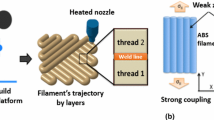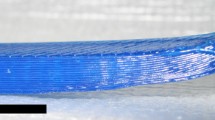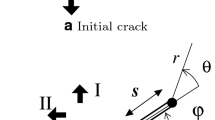Abstract
Fused filament fabrication (FFF), commercially known as fused deposition modelling (FDM), is a widespread 3D printing process that builds up components by depositing a continuous filament of material, typically a thermoplastic, along a deTermined path. The mechanical performance of such parts is promising, even if strongly influenced by the deposition process. In this work, the mechanical behaviour of a specific lattice structure printed in acrylonitrile butadiene styrene (ABS) is studied and a model of lattice behaviour up to the damage regime is developed, with emphasis on the resulting anisotropy. The investigation starts with the analysis of the anisotropy of simple prismatic samples printed with various filament orientations. Deformation and damage of the lattice structure under compressive loading is observed at the meso- and micro-scales. An anisotropic model is then developed within the ABAQUS© environment to reproduce the elasto-plastic behaviour, incorporating onset and evolution of inter- and intra-layer damage. Good agreement is observed between the modelled and experimental response.
Similar content being viewed by others
Abbreviations
- \({\dot \varepsilon_c}\) :
-
Compression strain rate [mm/mm · s−1]
- σ u,flex :
-
Maximum bending stress [MPa]
- E flex :
-
Flexural modulus [MPa]
- ε f,t :
-
Failure strain value for the transverse direction [mm/mm]
- ε f,p :
-
Failure strain value for the isotropy plane [mm/mm]
- ε th,p :
-
Threshold strain value for damage initiation [mm/mm]
- D :
-
Damage variable
References
A. R. Torrado et al., Characterizing the effect of additives to ABS on the mechanical property anisotropy of specimens fabricated by material extrusion 3D printing, Additive Manufacturing, 6 (2015) 16–29.
C. S. Lee, S. G. Kim, H. J. Kim and S. H. Ahn, Measurement of anisotropic compressive strength of rapid prototyping parts, Journal of Materials Processing Technology, 187–188 (2007) 627–630.
V. Vega et al., The effect of layer orientation on the mechanical properties and microstructure of a polymer, Journal of Materials Engineering and Performance, 20(6) (2011) 978–988.
W. Wu et al., Influence of layer thickness and raster angle on the mechanical properties of 3D-printed PEEK and a comparative mechanical study between PEEK and ABS, Materials, 8(9) (2015) 5834–5846.
C. Ursini and L. Collini, FDM layering deposition effects on mechanical response of TPU lattice structures, Materials, 14 (2021) 5645.
J. T. Cantrell et al., Experimental characterization of the mechanical properties of 3D-printed ABS and polycarbonate parts, Rapid Prototyping Journal, 23(4) (2017) 811–824.
Q. Sun, G. M. Rizvi, C. T. Bellehumeur and P. Gu, Effect of processing conditions on the bonding quality of FDM polymer filaments, Rapid Prototyping Journal, 14(2) (2008) 72–80.
S. Garzon-Hernandez, D. Garcia-Gonzalez, A. Jérusalem and A. Arias, Design of FDM 3D printed polymers: an experimental-modelling methodology for the prediction of mechanical properties, Materials and Design, 188 (2020) 108414.
M. Rybachuk, C. A. Mauger, T. Fiedler and A. Ochsner, Anisotropic mechanical properties of fused deposition modeled parts fabricated by using acrylonitrile butadiene styrene polymer, Journal of Polymer Engineering, 37(7) (2017) 699–706.
S.-H. Ahn et al., Anisotropic material properties of fused deposition modeling ABS, Rapid Prototyping Journal, 8(4) (2002) 248–257.
C. Ziemian, M. Sharma and S. Ziemian, Anisotropic mechanical properties of ABS parts fabricated by fused deposition modelling, Mechanical Engineering, InTechOpen, London (2012).
T. Vukasovic, J. F. Vivanco, D. Celentano and C. M. García-Herrera, Characterization of the mechanical response of thermoplastic parts fabricated with 3D printing, The International Journal of Advanced Manufacturing Technology, 104(9–12) (2019) 4207–4218.
A. Nazir, K. M. Abate, A. Kumar and J.-Y. Jeng, A state-of-the-art review on types, design, optimization, and additive manufacturing of cellular structures, The International Journal of Advanced Manufacturing Technology, 104 (2019) 3489–3510.
T. Wester, Nature teaching structures, International Journal of Space Structures, 17(2–3) (2002) 134–147.
L. J. Gibson and M. F. Ashby, Cellular Solids: Structure and Properties, Cambridge University Press (1997).
L. Collini, C. Ursini and A. Kumar, Design and optimization of 3D fast printed cellular structures, Material Design and Processing Communications, 3(4) (2021) e227.
A. Kumar, L. Collini, A. Daurel and J.-Y. Jeng, Design and additive manufacturing of closed cells from supportless lattice structure, Additive Manufacturing, 33 (2020) 101168.
A. Kumar, L. Collini, C. Ursini and J.-Y. Jeng, Energy absorption and stiffness of thin and thick-walled closed-cell 3D printed structures fabricated from a hyperelastic polymer, Materials, 15(7) (2022) 2441.
X.-Y. Zhang, G. Fang and J. Zhou, Additively manufactured scaffolds for bone tissue engineering and the prediction of their mechanical behavior: a review, Materials, 10(1) (2017) 50.
Z. Alomar and F. Concli, A review of the selective laser melting lattice structures and their numerical models, Advanced Engineering Materials, 22(12) (2020) 2000611.
M. R. O’Masta, L. Dong, L. St-Pierre, H. N. G. Wadley and V. S. Deshpande, The fracture toughness of octet-truss lattices, Journal of the Mechanics and Physics of Solids, 98 (2017) 271–289.
I. Maskery, N. T. Aboulkhair, A. O. Aremu, C. J. Tuck and I. A. Ashcroft, Compressive failure modes and energy absorption in additively manufactured double gyroid lattices, Additive Manufacturing, 16 (2017) 24–29.
H. Blom, R. Yeh, R. Wojnarowski and M. Ling, Detection of degradation of ABS material via DSC, Journal of Thermal Analysis and Calorimetry, 83 (2006) 113–115.
J. Lemaitre, A continuous damage mechanics model for ductile fracture, Journal of Engineering Materials and Technology, 107 (1985) 83–89.
C. Bhat, A. Kumar and J.-Y. Jeng, Effect of atomic tassellations on structural and functional properties of additive manufactured lattice structures, Additive Manufacturing, 47 (2021) 102326.
Author information
Authors and Affiliations
Corresponding author
Additional information
Alberto Corvi is a Ph.D. student in the University of Parma, Parma, Italy. His research interests include Numerical Modelling, Computational Mechanics and Additive Manufacturing.
Luca Collini is Associate Professor at the Department of Engineering and Architecture of the University of Parma, Italy. His research interests include Numerical Modelling, Computational Micromechanics and Fatigue and Fracture of Materials.
Corrado Sciancalepore is researcher at the Department of Engineering and Architecture of the University of Parma, Italy. He is expert of polymers and his research focuses on the development of new eco-materials.
Ajeet Kumar is Assistant Professor at the NTUST University of Taipei, Taiwan, and researcher at the High-Speed 3D Printing Research Center, Taiwan Tech. He works on advanced and innovative Additive Manufacturing processes and structures.
Rights and permissions
About this article
Cite this article
Corvi, A., Collini, L., Sciancalepore, C. et al. Analysis and modelling of damage mechanism in FDM 3D-printed lattice structure under compression loading. J Mech Sci Technol 37, 1089–1095 (2023). https://doi.org/10.1007/s12206-022-2104-4
Received:
Revised:
Accepted:
Published:
Issue Date:
DOI: https://doi.org/10.1007/s12206-022-2104-4




